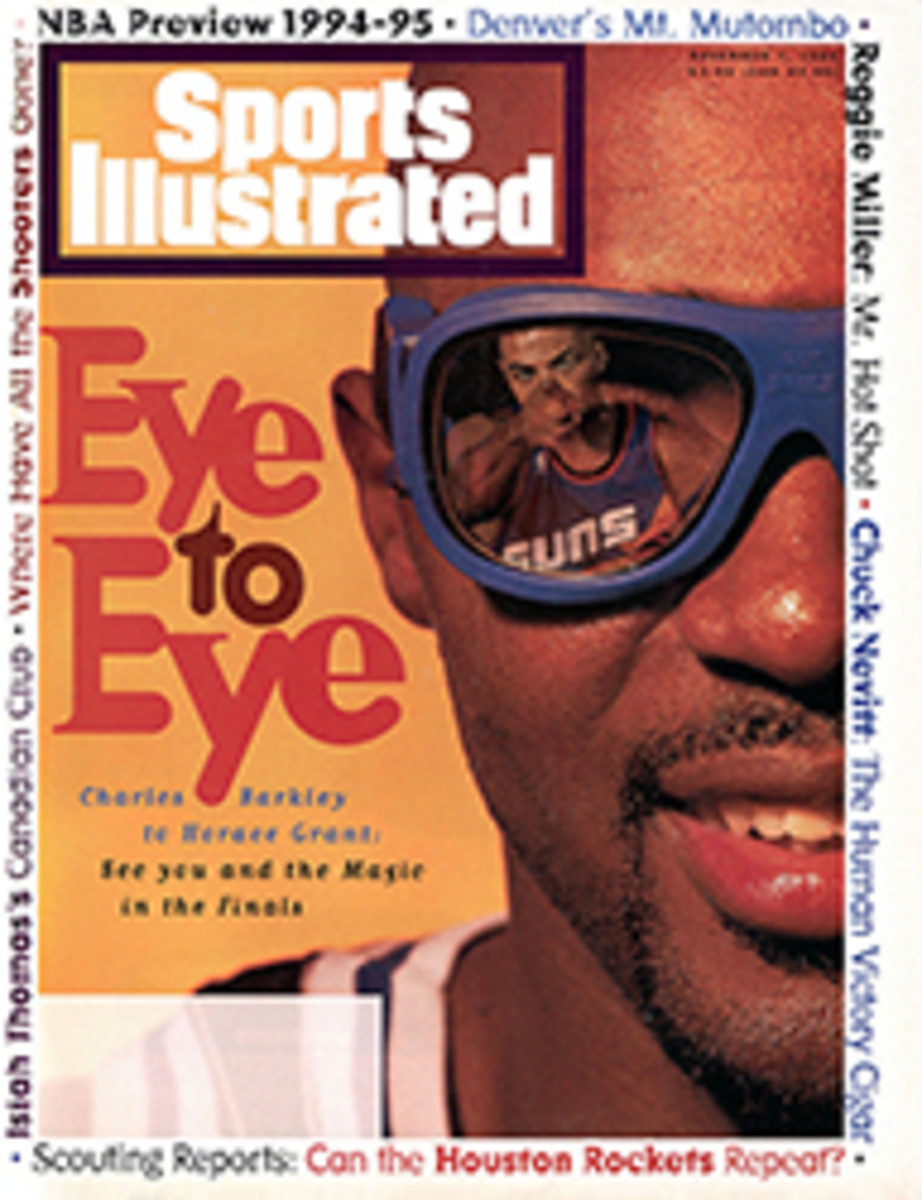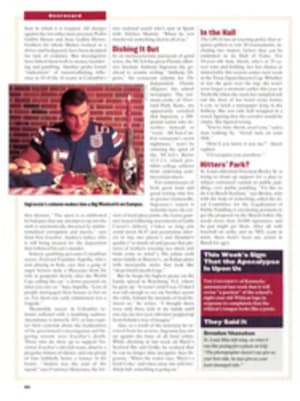
THE NFC CENTRAL
Beware Sharp Corners
When Viking coach Dennis Green cut veteran Pro Bowl cornerbacks Audray McMillian and Carl Lee in the off-season and created the vacancies filled by rookie Dewayne Washington and journeyman Anthony Parker, it looked like Minnesota had gotten caught in a salary-cap squeeze and would be vulnerable at the corners this season. Well, that's what it looked like to everyone but Green. "Contrary to what people think," the Viking coach says, "cornerback was the weakest part of our defense last year."
Sure enough, the Minnesota defense has hardly missed a beat without the two All-Pros this season. It was ranked No. 1 in the NFL last year; this season it was ranked No. 4 through Sunday's games. But that still hasn't stopped teams from thinking that the no-name corners are a weak link.
On Sunday, Tampa Bay became the latest team to learn that the new corners are not to be trifled with. In Minnesota's 36-13 victory over the Bucs at Tampa Stadium, Parker intercepted a Craig Erick-son pass and returned it 41 yards for a touchdown in the first quarter, and Washington intercepted rookie quarterback Trent Dilfer at the end of the third quarter to set up a Fuad Reveiz field goal. It was the third straight game in which Parker has scored, and Washington now has three interceptions on the season.
On paper the new corners certainly appear to be exploitable. Washington is a 21-year-old first-round pick out of North Carolina State. Parker, meanwhile, is a 28-year-old veteran who has had a cup of coffee with four NFL teams and twice has been waived out of football altogether. His biggest claim to fame was leading the now-defunct World League in interceptions in 1991 with 11.
Says defensive coordinator Tony Dungy, "Carl and Audray were tremendously experienced, and they did a lot for our defense. But they were in their early 30's, and it's a young man's game. They relied on savvy and experience. These two corners are stronger and faster."
That message apparently hasn't gotten around to the rest of the NFL. "I understand where all this 'weak link' talk comes from," Parker says. "Anytime you get rid of two Pro Bowlers on a defense that was ranked Number 1 in the NFL, and you replace them with two guys nobody ever heard of, you're bound to be criticized. That's a lot to live up to. It's up to us to let people know that we can make plays."
Says Washington, "From the start of the season, teams have picked on us. I'm a rookie, so I know they'll come at me. But we try to make our mark so that next time they know we're not the weakest part."
Parker's climb to his current role with the Vikings was hard. He was originally projected to be a No. 1 draft pick out of Arizona State, but he tore the anterior cruciate ligament in his left knee in the sixth game of his senior season and went undrafted in 1988. He finally signed as a free agent with Indianapolis in 1989. He knocked around with the Colts, the Jets, the Cardinals and the Chiefs without much luck before coming into his own with the New York/New Jersey Knights of the World League. His success convinced the Vikes to give him a shot in '92.
"The Vikings were a new beginning in the NFL for me," says Parker. "Nobody believed in me before. I knew if I stayed healthy and was on the field on a consistent basis, I could play in this league."
Mr. Versatility
In seasons past, the rap on Green Bay linebacker Bryce Paup was jack-of-all-trades, master of none. A sixth-round pick from Northern Iowa in 1990, Paup has played just about every linebacker and defensive-line position since signing with the Packers four years ago. Suddenly, however, Paup's maneuverability has earned him respect. He's now recognized as one of the most complete linebackers in the game—an explosive pass rusher and a strong run stuffer who is still capable of dropping back into pass coverage.
"To be honest, getting to be so versatile has been a very frustrating process," says Paup, who plays primarily at outside linebacker but moves to defensive end in most passing situations. "It took a lot of maturing as a player and a person. I worried that I'd never master one position. I never bitched—well, not to my coaches anyway. Now, though, I wouldn't have had it any other way."
Most of the complaining took place in 1992, Mike Holmgren's first year as coach. Paup held out during training camp in a contract dispute and then floundered. He started six games at outside linebacker but was so ineffective in pass coverage that he was replaced by George Koonce. "I had no clue," Paup admits.
But that didn't last long. After the season, Paup enrolled in martial-arts classes to enhance his pass-rush moves. And he made it a point to prepare for every position by recording in a notebook each offensive play he faced, particularly the pass routes he saw. He also studied as much videotape as he could.
All that work paid off this past July. Paup was battling Fred Strickland for the middle linebacker spot when suddenly he was moved to outside linebacker to replace the injured Wayne Simmons. This time Paup aced the job. Even though Simmons is now healthy, Paup's fine play has kept him on the bench.
"Bryce is very valuable," says defensive coordinator Fritz Shurmur. "Opponents have to find him on the field. Is he a linebacker or a defensive lineman? Is he pass rushing or is he dropping back? They have to figure out what he is."
A Bright Spot in Tampa
For the past 12 months Tampa Bay wide receiver Lawrence Dawsey has been struggling through an arduous rehabilitation following surgery on his left knee to repair a torn anterior cruciate ligament. The hard work finally paid off on Oct. 23 when he returned for his first game action against the 49ers. In the second quarter, quarterback Trent Dilfer faded back and fired a short pass to Dawsey, and...Dawsey dropped it. With his team driving just before halftime, Dawsey got another chance, and...he dropped the ball again.
All of that physical therapy had not prepared him for the battle of nerves an injured player sometimes has to fight. "I was worrying about the knee, and I dropped those two balls because of it," says Dawsey. "I kept waiting for the hit, but it never did come."
It had to be particularly disconcerting for Dawsey, who prior to his injury was known as one of the best young possession receivers in the NFL, a player who made his living catching balls in traffic. "I told myself, Hey, you've got to hold on to the ball." says Dawsey. "You can't have fear on the field, because it will hurt you in the long run."
By game's end he had heeded his own counsel. He finished the game as the Bucs' top receiver with four catches for 65 yards, including a 34-yard TD play. On Sunday he led all Buc receivers again with five catches for 73 yards as the Bucs lost to the Vikings 36-13.
There hasn't been much to smile about in Tampa Bay this season as the Bucs have fallen to 2-6, but Dawsey's comeback has been one reason to cheer. The hard work he put in to his rehabilitation inspired his teammates. "I think I jumped higher than he did when he scored that touchdown against the 49ers," says Buc strength coach Brad Roll.
Bearing Up Well
No one would blame Bear rookie running back Raymont Harris for being a little apprehensive these days. With the sudden retirement of veteran fullback Merril Hoge on Oct. 17 due to postconcussion syndrome, the Bears have had to throw Harris, a halfback who was never called on to block much in college, into the breach. But the fourth-round pick from Ohio State, who is scheduled to make his third start of the season in Monday night's game against the Packers, claims he's feeling no pressure. Why?
"I meditate every day to keep my sanity," says the taciturn Harris, whose nickname is Quiet Storm. "I'll turn off the lights, put on some jazz, light incense and rock in my rocking chair. I think about life, put things in perspective. A person can lose his sanity quickly in the NFL."
Compared with most NFL fullbacks, the six-foot, 225-pound Harris is a little too small. And as running backs go, he's a little too slow. What he does have is a nice combination of abilities: the moves to run around tacklers and the strength to run through them. He gained 1,344 yards for the Buckeyes last season, and going into Monday night's game, Harris had run for 155 yards on 34 carries this season.
In Chicago's ball-control, short-passing game, Harris says he isn't primarily a blocker, as many fullbacks are, and that suits him just fine. "First and foremost, I'm not a fullback," Harris says. "I'm still a running back deep down. I've never seen another runner with my style. My best asset is my determination, that second effort I give after the initial contact. And that comes from the heart."
PHOTO
A rush from John Randle & Co. can keep QBs like Erickson from testing the Vikes' no-name corners.
PHOTO
WALTER IOOSS JR.
Teams that have tried to pick on Washington have seen those efforts come back to haunt them.
PHOTO
WALTER IOOSS JR.
After some shaky moments, Dawsey has gotten a grip again.

